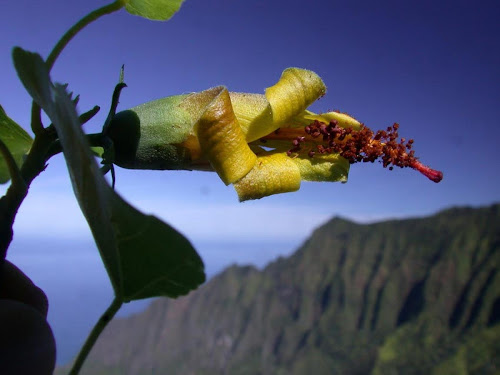Vanished blossom rediscovered in Hawaii, through drones
The remote, tough high cliff deals with of Kalalau Valley on Kaua'i, Hawaii, are mostly unattainable to people. For years, scientists from the Kaua'i-based Nationwide Exotic Botanical Yard (NTBG) accessed these high cliffs by treking along treacherous ridgelines and rappelling down upright high cliff deals with, scouring each nook and cranny for unusual indigenous plants. Now they have a brand-new device to assist them: drones.
In late January, a drone trip made a surprising exploration: Hibiscadelphus woodii, a family member of hibiscus last seen in 2009 and thought to be vanished, was still expanding on the cliffside.
The types wased initially found in 1991, called in 1995, and considered vanished in 2016. It has dynamic yellow blossoms, which move to a purplish shade in time. Scientists think it's pollinated by indigenous birds. While researchers had attempted to utilize cross-pollination, grafting, and suggestion cuttings to propagate the grow, none of their tries succeeded.
The January drone trip caught one picture thought to be H. woodii, put right into an edge. In February, they laid out on one more objective to reconfirm what they saw, flying a drone to the initial GPS coordinates and gathering much a lot extra pictures, exposing 3 private H. woodii plants on the cliffside.
"We were wishing to capture it in blossom, however it had not been blooming during that time," states Ben Nyberg, drone expert for NTBG. (See exactly just how drones are utilized for preservation.)

Nyberg was piloting the drone that made the exploration. He utilizes a grid system to check the high cliffs, likewise utilizing his instinct to house know spots to browse. Nyberg gathers GPS factors and notes associates such as altitude so plants could be discovered once once more.
However also if they understand where the plants are, getting to them isn't really simple. The 3 H. woodii plants remain in such a harmful and difficult-to-reach place 500 to 600 feet listed below the ridgeline that nobody has had the ability to take a trip to them yet.
"We've took a look at potentially brief transporting someone to enter there, however the high cliff area is so upright and it is up until now down the high cliff that we're uncertain that there would certainly suffice area for a helicopter to in shape there," Nyberg states. "It would certainly be really challenging and harmful for somebody to also reach the leading of the high cliff to rappel to it."
Nevertheless, they're wishing brand-new innovation could assist with this problem. They are presently examining a drone that could gather cuttings of plants, and they wish to utilize this brand-new innovation to have higher accessibility to cliffside plants. NTBG has been utilizing drones for about 2 and a fifty percent years in the location, which is referred to as a biodiversity hotspot. (See the unexpected methods drones are conserving lives.)


